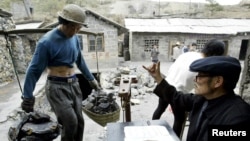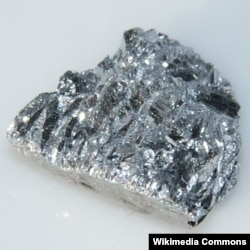China’s launch of export controls on antimony and certain superhard materials starting September 15 is a reminder, analysts say, that the United States needs to expand its sourcing of the critical mineral as the tech rivalry between the world’s two biggest economies continues.
Antimony is a chemical element used in a range of products from night goggles and batteries to military ammunition and nuclear weapons. A large portion of U.S. imports come from China. Analysts say that while the move presents a challenge, there are ways Washington can and is already adapting.
According to U.S. Geological Survey data, China is the largest producer of antimony, accounting for 48% of the world’s mined output. The export restrictions, which go into effect Sunday, follow similar curbs imposed by China last year on gallium, germanium, and other rare earth elements.
Some see the move by Beijing to restrict the export of antimony as a retaliatory response to U.S. limits on China’s access to certain advanced technologies, such as semiconductors.
Beijing has said the export controls are not targeted at any specific region and are meant to “safeguard national security and interests, and fulfil international obligations such as non-proliferation,” according to its China’s Commerce Ministry.
The United States categorizes antimony as a “mineral critical to economic and national security — similar to rare earth elements, plus cobalt and uranium,” according to the U.S. International Trade Commission, and is currently the largest buyer of China’s antimony.
Washington used 22,000 tons of antimony in 2023, a figure that totaled roughly one-quarter of the global demand for the mineral.
Alicia Garcia-Herrero, chief economist for Asia Pacific at the French investment bank Natixis, told VOA that China “produces 63% of the antimony that the U.S. imports.”
David Hammond, a senior mineral economist from Colorado, said that despite the U.S. reliance on China, the export limits from China will not have a major impact on the United States.
“I don't think people should be overly worried about the Chinese cutting off antimony sales. I think they're concerned, and if they use their heads, there are ways to secure supplies from alternate sources to the amount that we need. But it takes time to develop that. You can't do it next week," he told VOA.
Garcia-Herrero also thinks the U.S. will explore alternative supply options to secure more antimony if necessary.
“The U.S. has been aware of this dependency [on China] and has been exploring alternative sources of antimony,” she told VOA in a Whatsapp response.
“For instance, there are efforts to develop antimony mining in Alaska, which could potentially reduce reliance on Chinese imports. Additionally, the United States Antimony Corporation is the only operating smelter in North America, and it has been looking into antimony supply possibilities from other countries,” she said.
Robert Dohner, senior fellow at the Atlantic Council, told VOA in an emailed response that “analysts often overreact to instances of Chinese export controls and overestimate the effects of these restrictions, particularly in the medium term,” and that the United States has several options to mitigate the effects of the antimony limit.
Washington could increase the recycling of antimony through lead-acid batteries, divert the use of antimony to its “highest priority uses,” and use “alternative materials if they exist,” he said, listing a few options.
Dohner, like Hammond and Garcia-Herrera, said increasing supply from sources other than China is also an option.
“Tajikistan, Myanmar, Australia, and even the United States are possible sources,” he said.
In February, the United States hosted an inaugural meeting of the C5+1 Critical Minerals Dialogue, where Washington met with Tajikistan and other Central Asian countries to strengthen economic cooperation and increase the region’s involvement in the global supply chain of critical minerals.









